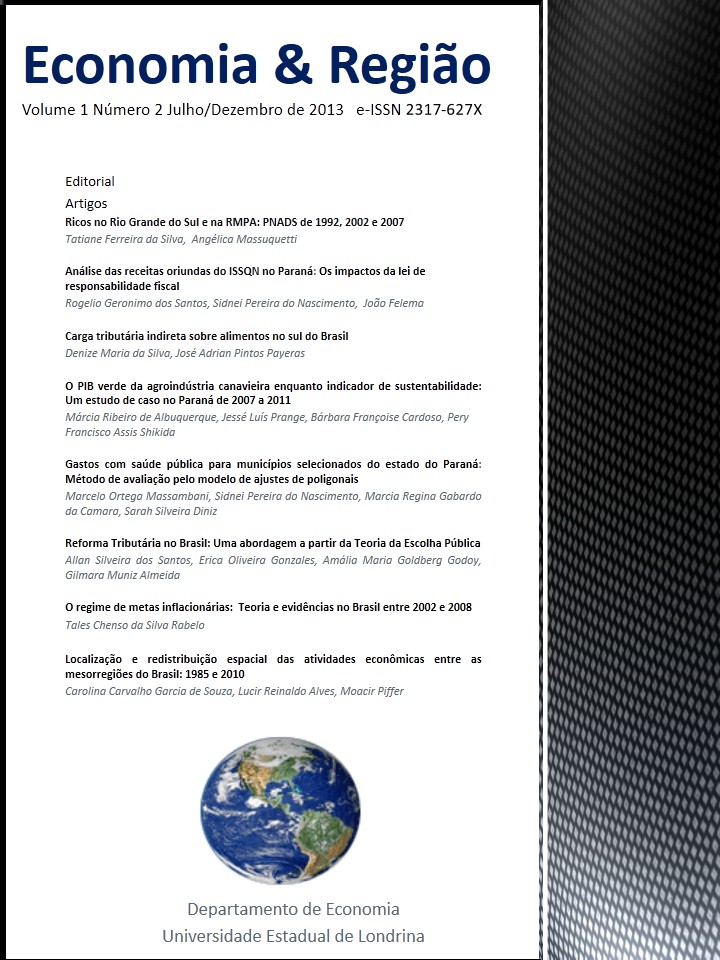Inflation Target System: Theory and evidences in Brazil between 2002 and 2008
DOI:
https://doi.org/10.5433/2317-627X.2013v1n2p118Keywords:
Brazil, Inflation Targeting, Macroeconomic Equilibrium, Economic PolicyAbstract
This paper highlights institutional and theoretical aspects of inflation targeting regime. It focus on Brazilian experience during 2002-2008 period. The analysis of key macroeconomic variables performance like growth rate, inflation rate and public debt, show that the economic policy options during this period were the right ones, and have led the country towards sustained economic growth. Nonetheless, through the period statistics, the paper verified empirically the monetary policy transmission mechanism and how the commitment with macroeconomic policy towards inflation targeting regime automatically stabilizes other key macroeconomic variables; forging the whole economy dynamic equilibrium. The paper also verifies the term structure of interest rate in the period.Downloads
References
BARRO, R. J.; GORDON, D. B. A positive theory of monetary policy in a natural rate model. Journal of Political Economy, v. 91, n. 3, p. 589-619, 1983.
BERNANKE, B. S.; GERTLER, M. Monetary policy and asset price volatility. In: SYMPOSIUM SPONSORED BY THE FEDERAL RESERVE BANK OF KANSAS CITY, Jackson Hole, Wyoming, Aug. 26-28, 1999. Proceedings ... Jackson Hole, 1999.
BERNANKE, B.; MIHOV, I. Measuring monetary policy. Quartely Journal of Economics, v. 103, p. 869–902, 1998.
BERNANKE, B; MISHKIN, F. S. Inflation targeting: a new framework for monetary policy? Journal of Economic Perspectives, v. 11, n. 2, p. 97-116, 1997.
BOGDANSKI, J.; TOMBINI, A. A.; WERLANG, S. R. Implementing inflation targeting in Brazil. Brasília, DF: Banco Central do Brasil, jul. 2000. p. 1-29, 2000. (Working Papers Series).
CALVO, G. On the time consistency of optimal policy in the monetary economy. Econometrica, v. 46, n. 4, p. 1411-1428, 1978.
CARNEIRO, D. D.; WU, T. Y. H. Contas externas e política monetária. Revista Brasileira de Economia, v. 58 ,n. 3, p. 301-323,2004.
CAVALCANTI, M. A.; VONBUN, C Reservas internacionais ótimas para o Brasil: uma análise simples de custo-benefício para o período 1999-2007. Econ. Apl. v. 12, n. 3, p.463-498, Jul./Set. 2008.
CÉSPEDES, B., LIMA, E; MAKA, A. 'Monetary policy, inflation and the level of economic activity in brazil after the real plan: stylized facts from svar models, Revista Brasileira de Economia, v. 62, p.123–160, 2008.
CLARIDA, R.; GALÍ, J.; GERTLER, M. Monetary policy rules and macroeconomic stability: evidence and some theory. Quarterly Journal of Economics, v. 115, n. 1, p. 147-180, 2000.
CHRISTIANO, L. J., EICHENBAUM, M.; EVANS, C, Monetary policy shocks: what have we learned and to what end?, In: Handbook of Macroeconomics. North Holland: Elsevier Science, 1999.
DEDOLA, L.; LIPPI, F. 'The monetary transmission mechanism: evidence from the industries of five oecd countries.' European Economic Review, v. 49, p.1543–1569, 2005.
EPSTEIN, G A; YELDAN E A. Beyond Inflation Targeting, Northhampton, MA, Edward Elgar, 2009.
FERNANDES, M.; TORO, J O Mecanismo de transmissão monetária na economia pós-Plano Real. Revista Brasileira de Economia, v. 59, n. 1, p.5-32, jan./mar. 2005.
FIGUEIREDO, F. M.; FERREIRA, T.P. Os preços administrados e a inflação no Brasil. Brasília, DF: Banco Central do Brasil, dez. 2002. p. 1-32. (Working Papers Series).
FISCHER, S. Modern Central Banking. In: CAPIE, F.; GOODHART, C.; FISCHER, S.; SCHNADT, N. (Ed.). The future of Central Banking. Cambridge: Cambridge University Press, 1994.
GARFINKEL, M. R.; OH, S. Strategic discipline in monetary policy with private information: optimal targeting horizons. American Economic Review, v. 83, n. 1, p. 99¬117, 1993.
GOLDFAJN, I et. al. Inflation Targeting, Debt, and the Brazilian Experience, 1999-2003. Cambridge, MA: MIT Press, 2005.
KING, M. The inflation target ten years on. Bank of England Quarterly Bulletin, v. 42, n. 4, p. 459-474, 2002.
KYDLAND, F.; PRESCOTT, E. C. Rules rather than discretion: the inconsistency optimal plans. Journal of Political Economy, v. 85, n. 3, p. 473-492, 1977.
LUCAS, R. 'Econometric policy evaluation: a critique.', Carnegie-Rochester Conference Series on Public Policy, v.1, p. 19-46, 1976.
MINELLA, A. Monetary policy and inflation in brazil (1975-2000): a var estimation. Revista Brasileira de Economia, v.57, 605–635, 2003.
MINELLA, A.; FREITAS, P.; GOLDFAJN, I.; MUINHOS, M. Inflation targeting in Brazil: constructing credibility under exchange rate volatility. Brasília, DF: Banco Central do Brasil, nov. 2003. p. 1-32. (Working Papers Series, n. 77).
MISHKIN, F. S. What should Central Banks do? Federal Reserve Bank of St. Louis Review, v. 82, n. 6, p. 1-13, 2000.
SIMS, C. A., STOCK, J. H., WATSON, M. W. 'Inference in linear time series models with some unit roots.' Econometrica, v. 58, p.113–144, 1990.
SVENSSON, L. E. O. Commentary on Meyer: practical problems and obstacles to inflation targeting. Federal Reserve Bank of St. Louis Review. v.86, n. 4, p. 161-164, 2004.
TAYLOR, J. B. Discretion versus policy rules in practice. Carnegie-Rochester Conference Series on Public Policy, p. 195-214, Dec. 1993.
TODA, H. Y.; YAMAMOTO, T. 'Statistical inference in vector autoregressions with possibly integrated processes.' Journal of Econometric. v. 66, p. 225–250, 1995.
Downloads
Published
How to Cite
Issue
Section
License
Economia & Região adota a Licença Creative Commons Attribution CC-BY 4.0 International, portanto, os direitos autorais relativos aos artigos publicados são do(s) autor(es), que cedem à Revista Economia & Região o direito de exclusividade de primeira publicação.
Sob essa licença é possível: Compartilhar - copiar e redistribuir o material em qualquer suporte ou formato. Adaptar - remixar, transformar, e criar a partir do material, atribuindo o devido crédito e prover um link para a licença e indicar se mudanças foram feitas.














